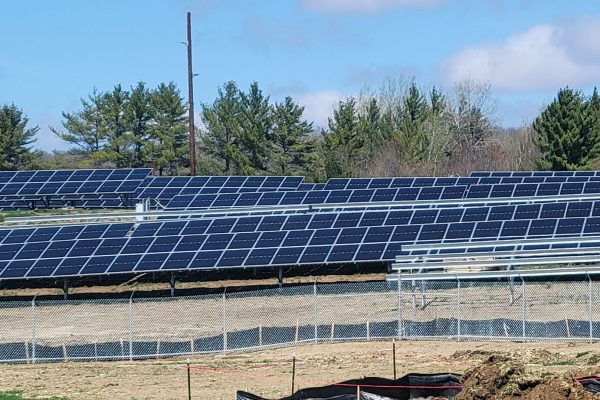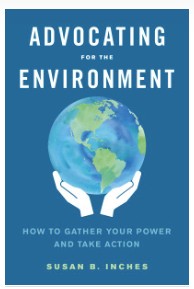Have you received multiple offers to sign up for solar and save money on your electric bill? Do you wonder if these offers are legitimate? Where’s the catch? How do these work? People are asking these questions, so I did a little research. Here’s what I found out.
There are two ways to engage in community solar—one is to invest and own a portion of a solar project, and the other is to subscribe to a solar project by agreeing to buy the electricity generated.
Owning a share in a project has high upfront costs and requires a long-term commitment to pay off the debt. It works well if you have the money to invest upfront. As an owner, you can capture tax credits and renewable energy certificates (RECS) to offset the cost. After the end of payback period (usually 8-10 years) you can reap the reward of free electricity.
Subscriptions to community solar farms offer a way to participate in solar without owning anything. You sign a contract to buy the electricity from a community solar farm, with no upfront fees or investment. Contracts can range from month-to-month up to 20 years. According to Maine law, customers can cancel within 5 day of receipt of the first bill or invoice, and solar providers often will allow other reasons for cancellation, including reasonable advance notice of 60-90 days.
How it Works

Part of New England’s largest solar farm in Farmington, Maine. Photo by Beth Comeau
The energy generated by community solar farms doesn’t go directly to subscribers’ homes, but instead is fed into the power grid. This reduces the need for fossil-fuel energy and reduces harmful emissions.
Community solar subscription programs allow ratepayers to participate in solar development and reap some of the benefits. The key to community solar is enabling legislation that allows “shared net energy billing.” Maine passed this legislation in 2019. Twenty-two states have similar legislation, and it is catching on quickly in other places, too.
“Net energy billing” means the difference between the quantity of solar power generated and quantity of solar power used. This means that excess solar power generated during the long days of summer appears as a kilowatt hour credit on your electric bill in the winter. By law, electric utilities must bank these “credits” and allow you to use them within 12 months. Your monthly electric bill is based on the net kilowatt hours.
The subscriber savings come from two sources: the reduced kilowatt hours (from net energy billing) and the difference between the wholesale and retail price of the power generated. Solar providers are paid wholesale for their power by the electric utilities, who then charge retail to their subscribers, based on rates set by the Public Utilities Commission. In other words, the solar providers are sharing a portion of their profits with us, the ratepayers. Your electricity costs are typically 10-15% lower than what you would pay without the subscription.
When you apply for a subscription, the solar provider offers you a share of the solar energy generated by a specific solar farm. Your share is based on a formula, which is 90% of the monthly energy you used over the last 12 months. This formula assures that you won’t be buying more solar energy than you can use.
Community solar farms in Maine are a win for developers, too. They receive a steady and profitable revenue stream from their subscribers, which enables them to finance and build more solar projects. This model has been so attractive that there are now well over 200 community solar farm projects in Maine.
So What’s the Downside?
There is very little risk to subscribers in community solar projects. Billing and systems glitches that occurred in the first year of these projects have been smoothed out. The biggest issue has been delayed launch dates for solar projects, which can be six months or longer. Electric utilities, Central Maine Power and Versant here in Maine, have been very slow to upgrade the grid and connect new solar projects to it. But this is primarily a problem for developers and not the subscribers, because subscriptions don’t kick in until the project goes live.
Some solar developers sell subscriptions before building their projects, creating longer delays. Here delays can be a year or more, as permitting, construction, and labor issues kick in. Potential subscribers can reduce delays by looking for completed projects with scheduled launch dates. But do take the launch dates “with a grain of salt,” since most projects are delayed by a few months.
Another thing to consider is siting. Here in Maine, there are guidelines for siting solar projects, but no laws in place. Unscrupulous solar companies can clear-cut a forest or use prime farmland for a solar project, defeating the purpose of preserving the environment. Potential subscribers should ask for project details, in order to avoid supporting poorly sited projects.
The other thing to know is that the market for community solar is booming. Maine, Minnesota, Colorado, Massachusetts, and New York lead the nation. Both Maine and Massachusetts are at the top of the list with well over 200 projects each.
Some providers are aggregators that offer a basket of solar projects to choose from; others are agents that market projects for a specific developer. Both of these types of operations are likely to be satisfactory.
A few are vertically integrated companies where developers and marketers are part of the same operation. The risk of delay is greater with these, because they often begin selling subscriptions long before permitting and siting are completed.
Solar providers in Maine must register with the Maine Public Utilities Commission (PUC). To avoid problems, Mainers should check to see if their provider is registered and read customer reviews. A link to a list of providers can be found here: https://www.maine.gov/meopa/electricity/renewable-energy/community_solar.
Solar subscribers should read their contracts before signing, too. Community solar providers are required to provide a standard disclosure form that summarizes project terms. Before signing, the Public Advocate recommends getting answers to the following questions:
- When will I receive my disclosure form? (Never sign a blank disclosure form).
- Am I getting $ discount or kWh credit (or both) on my monthly electricity bills?
- When will the project come online? When will I start to receive credits and savings?
- Do I receive credit for a fixed amount each month or a credit to match my monthly usage?
- How long is the contract term?
- Will this facility always generate enough to cover my use?
- What is the cancellation policy? What happens if I move?
- Do I need a smart meter to participate?
The Bottom Line
Maine community solar offers an easy and almost risk-free way for ratepayers to participate in solar. The average monthly savings of $8-$12 are small, but can make a difference in low- or fixed-income households. The added value is in knowing that you have helped reduce carbon emissions, supported renewable energy investment, and taken a step toward achieving state and global climate goals. After researching this article, I joined a solar farm!


—by Sue Inches, author of the recently released guidebook, Advocating for the Environment, How to Gather Your Power and Take Action, available online and at bookstores everywhere
Sources:
Steve Weems, Director, Maine Solar Energy Association
Kay Mann, Power Market, LLC
Turkel, Tux; Long delay casts shade on Maine’s community solar development, Portland Press Herald, Dec. 13, 2021
Maine Office of the Public Advocate, https://www.maine.gov/meopa/electricity/renewable-energy/community_solar
Note: this post was updated to clarify contract length and cancellation options.










I am experiencing some of the complications of Community Solar. As I understand it, by my contract with my provider I pay for an allocation of the power generated at their solar farm, estimated to be 90% of my annual usage. The rate I pay my provider is reportedly 90% of the CMP standard offer rate. However, my usage varies significantly because my account is for my second home, and I use it sporadically – sometimes a lot, sometimes a little, so my usage varies. If I use it for less than estimated by my provider I risk losing some credits, which expire in 12 months if not used. Given I stand to save at most 10% on my electric bill, there’s a real possibility my expired credits will significantly reduce my savings, totally eliminate them, or even cause a loss for me relative to what I would have paid CMP. I can try to monitor my credits and usage and manage my account by changing my allocation to try to match my usage, but that’s a level of effort that probably won’t feel worth it for at most a 10% savings (if I manage it perfectly).
Another discouraging aspect is that I believe Community Solar investors have gotten substantial “raises” when the standard CMP rates rose, even thought their costs probably did not rise at the same rate, leading to a windfall for them not shared with users. In a more competitive market I think it would be shared, users’ costs would fall, and the demand for solar would accelerate.
I’m a strong believer in the need to develop renewables quickly, but am concerned not only for my own pocketbook, but also that when some Community Solar users like me are surprised to learn they lost money because of the unaligned production allocation and usage, it will give solar power a bad name and slow its adoption.
Am I missing something? Thanks for your consideration.
Hello Jeff,
We appreciate this comment and recognize that you have investigated this issue thoroughly. It is certainly true that there have been complications and questions as community solar in Maine is still a very new industry. However, we have never heard reports of individuals losing money by signing up for community solar. Your utility uses your past usage to estimate your future annual usage, so your usage estimation should be consistent with your regular use of the property. If you find this not to be the case, you can request that your usage estimate be re-evaluated the following year.
Fortunately, the 2022 Legislature shared your concern about community solar developers benefiting from rising utility rates and passed a bill (LD 634) that froze compensation for solar developers, helping to decouple their revenue from rate increases caused by our dependence on fossil fuels.
To ensure that you are receiving the full benefits community solar has to offer and to resolve any complications you are experiencing, we recommend looking at the Maine Office of the Public Advocate page on community solar (https://www.maine.gov/meopa/electricity/community_solar) and contacting their office with any concerns. They have dedicated staff to help consumers with any difficulties they are experiencing with community solar. Further, the organization Maine Community Solar has representatives to answer questions and resolve issues.
I hope this is helpful! Please reach out any time with additional questions or concerns.
We are facing a project now in North Berwick Maine. My understanding is this project will be on a considerable amount of wet lands, vernal pools, etc.
My question is, how can we in North Berwick, be assured that because land becomes available, by a private party, that the land is and will be protected properly?
I would like to think the whole idea of solar energy is in essence to protect our environment.
Thank you for reaching out about this issue. As you are certainly aware, clean energy implementation and siting can be a tricky subject, as we simultaneously need to build the clean energy infrastructure our state needs to end our dependence on fossil fuels and reduce our greenhouse gas emissions while also avoiding undue environmental damage.
Any project over 20 acres needs to receive a site law permit from Maine DEP. That review ensures local wildlife, vegetation, and water bodies are not adversely impacted.
For more information on sensible solar siting, please see this resource we helped to create along with Maine Audubon: https://maineaudubon.org/advocacy/solar/
There are always tradeoffs when it comes to clean energy development, and we hope that in this case, the benefit to Maine energy consumers and the attention to environmental protection will outweigh any negative impacts in your area. Solar installations do not lead to toxic runoff and are generally compatible with local ecology. Solar is often co-located with grazing animals as panels are not immediately dangerous to wildlife. They do, however, displace land that may have previously been used by a range of animals, and we are continuing to work with state agencies and lawmakers to ensure that clean energy siting policies are keeping pace with the rate of clean energy development.
We appreciate your outreach and are always happy to answer any questions you may have.
I understand solar panels get very hot. (Seems logical). So, on large solar farms, the air above the panels heats up significantly more than the natural ground surface. Warm air holds more moisture, and warm air rises, putting more moisture into the atmosphere.
Perhaps one solar farm has little impact on climate change, but collectively, and as more and bigger farms are built, I am concerned we will experience more thunder storms and more severe weather patterns.